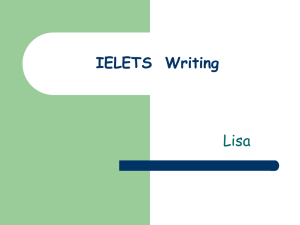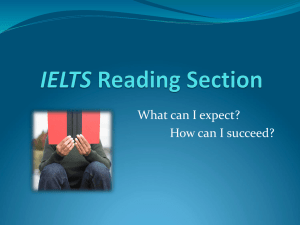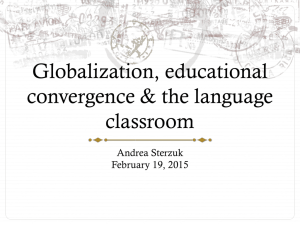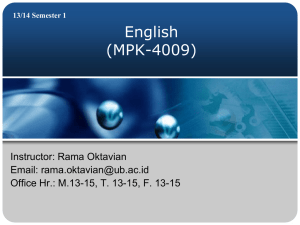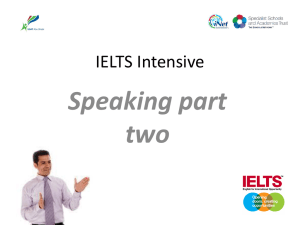Your Official Source on US Higher Education
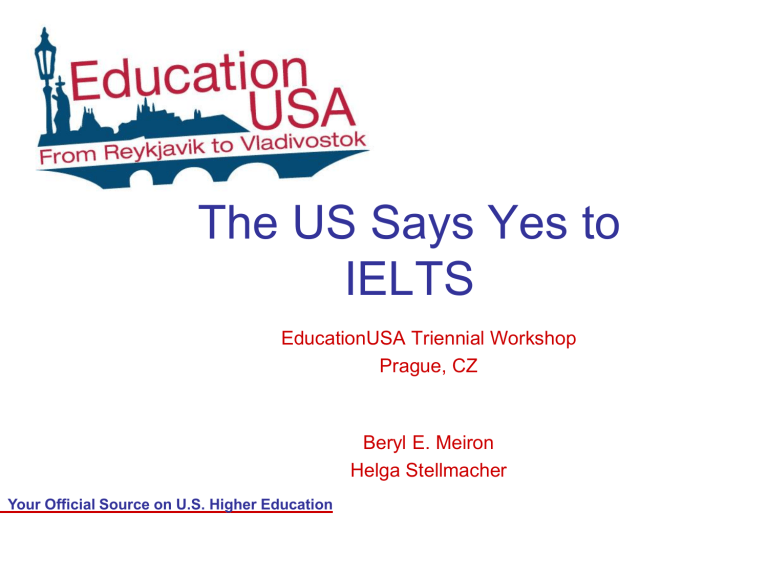
The US Says Yes to
IELTS
EducationUSA Triennial Workshop
Prague, CZ
Your Official Source on U.S. Higher Education
Beryl E. Meiron
Helga Stellmacher
Today’s Agenda
1.
Introduction to IELTS
• What makes a good language proficiency test?
• History, statistics and US recognizing institutions views of IELTS
2. IELTS Fundamentals and Format
• The test modules: listening, reading, writing and speaking
• Scoring
• A look at the speaking test in detail
3.
Stakeholder services
• IELTS in Eurasia What’s available to you: test centers, online resources, preparation material, assisting advisees with IELTS
• Stakeholders in the US – What’s available to receiving institutions:
TRFVS, electronic score downloads, etc.
4.
Questions / answers
Your Official Source on U.S. Higher Education
What is IELTS?
A test of English as an international language designed....
1.
To assess the English language ability of non-native speakers who intend to study at undergraduate, graduate and professional schools where English is the language of communication
2.
To test communicative language proficiency
3.
As a 4-skills test including listening, reading, writing, and a live, face-to-face speaking test performed by a trained, certified ESL professional
Your Official Source on U.S. Higher Education
An extensive history and testing heritage
• 1970s - “ELTS” (English Language Testing Service) test introduced by the British Council
• 1989 - IELTS international joint partnership formed
• 1995 - major content revision
• 2001 - revised speaking test (3 sections)
• 2005 - revised writing assessment criteria
• 2007 - launch of half-band scores for writing and speaking
• 2008 - web-based administration system
• 2009 - 20 th birthday celebration, launch of new website
• Upcoming – internet-based test delivery
Your Official Source on U.S. Higher Education
What are the characteristics of a good English language proficiency test?
…and why are more and more US schools recognizing IELTS?
– Validity (content and construct)
– Reliability
– Impact (washback, test takers, stakeholders)
– Practicality
Your Official Source on U.S. Higher Education
Validity
• Ongoing research and continuing development on construct and content validity
• Test content matched to test taker and stakeholder needs o Task-based items using multiple task types (geared to learning and test taking styles) o Integrated skills o Face-to-face speaking o Pen and paper delivery
Your Official Source on U.S. Higher Education
Reliability
• Test material production o Test paper production process is a 2-year process – pre-editing to live item release o International item writing teams – US, Canada, UK and Australia o All test versions are unique
• Assessment o Clerical markers (listening and reading) o Examiners (writing and speaking) o Must meet minimum professional requirements o Trained, certified by examination, performance monitored o Regularly standardized, monitored and retrained and recertified
Your Official Source on U.S. Higher Education
Practicality
• 48 test dates annually – Saturdays and Thursdays
• Registrations accepted close to test day
• Results available in 13 calendar days
• Special needs candidates
• “Enquiry on Results”
• Security o Time zones o Staff training and center audits (announced and unannounced) o Multiple test taker identity checks throughout the test day o Results cancellation o TRF verification website
Your Official Source on U.S. Higher Education
Impact
• High stakes
• Consequences for
• Test takers
• Sponsors
• Receiving institutions
• Teachers
• Publishers
• Academic researchers
• Government agencies
• Washback - consequences on the teaching / learning environment
Your Official Source on U.S. Higher Education
2009
2008
2007
2006
2005
2004
2003
2002
2001
2000
Global candidature growth:
1.4 million test takers in 2009
0 500,000 1,000,000 1,500,000
Your Official Source on U.S. Higher Education
General
Global Candidature
Breakdown (2009)
Academic
Your Official Source on U.S. Higher Education
“Top 10” for US-bound Students (Global)
Nationalities of test takers
1. China
2. Philippines
3. India
4. Saudi Arabia
5. South Korea
6. Nepal
7. Hong Kong
8. Thailand
9. Vietnam
10. Libya
Countries where tests are taken
1. China
2. United States
3. Philippines
4. India
5. Nepal
6. South Korea
7. Hong Kong
8. Vietnam
9. Thailand
10. France
Your Official Source on U.S. Higher Education
“
Top 10” for US-bound Students (Eurasia)
Countries where tests are taken
1. France
2. Germany
3. Italy
4. Russia
5. Turkey
6. Spain
7. Kazakhstan
8. Switzerland
9. Belgium
10. Netherlands
Your Official Source on U.S. Higher Education
Assisting international student recruitment
Online searches for US and globally-recognizing schools
Your Official Source on U.S. Higher Education
Boston University, Boston, MA http://www.bu.edu/admissions/apply/international/application-instructions/
Your Official Source on U.S. Higher Education
MIT, Boston, MA
http://math.mit.edu/academics/grad/admission/
Your Official Source on U.S. Higher Education
“We prefer applicants take IELTS to demonstrate English proficiency over other methods. Students who use IELTS when applying are consistently able to communicate at the tested level upon arrival. In our experience, we have never had a student with an adequate IELTS score arrive on campus and have difficulty communicating in English.
Students and families consistently report that IELTS is more available, has shorter waiting periods, and provides better customer service than other English proficiency exams.”
Don Buegel
Director of International Recruiting and Support
Concordia College
Moorhead, MN
Your Official Source on U.S. Higher Education
"I think IELTS has always been very responsive to both of their client populations - the students and the schools.
I think the environment for the test is a little more comfortable for people because there is the person-toperson .
We feel it is reliable, it's valid, and they're very responsive to our needs .“
Dr. Kristin Williams
Assistant Vice President for Graduate and Special Enrollment
Management
The George Washington University
Your Official Source on U.S. Higher Education
"The advantage of IELTS is that it is as rigorous as other tests, but it just makes students feel more comfortable when they take it.
I work for Boston University and I know that many schools and colleges accept IELTS for admission.
I think in the United States, IELTS is becoming much more well-known and accepted by universities and is really setting the standard for college admissions.”
Dr. Carol Pinero
Boston University
Center for English Language and Orientation Programs
Your Official Source on U.S. Higher Education
Europe Speaks IELTS!
• Dramatic increase in uptake by HEIs
•Entry/study placements/progress/exit
• HEC, Sciences Po (France),
Webster University (Austria), Vesalius
College, UCL (Belgium), Mannheim
Business School, Frei University,
(Germany), Bocconi, Turin/Milan
Polytechnic (Italy), ESADE, IESE
(Spain) University of Amsterdam
(Netherlands)
Your Official Source on U.S. Higher Education
How is IELTS Scored? Band Scores
IELTS uses a 9-point scoring system to measure and report test scores (See www.ielts.org
and Guide )
3
2
1
0
5
4
9
8
7
6
Expert User
Very Good User
Good User
Competent User
Modest User
Limited User
Extremely Limited User
Intermittent User
Non User
Did Not Attempt the Test
Most frequently used scores for US admissions
Your Official Source on U.S. Higher Education
9.0 - Expert user
IELTS
IELTS and the CEFR
C2 - Mastery
8.0 – Very good
CEFR
7.0 – Good user
6.0 – Competent user
5.0 – Modest user
4.0 – Limited user
C1 - Effective Operational Proficiency
B2 - Vantage
What scores do US schools require for academic success?
Levels/Sample Schools
Undergraduate
New York University
UIUC
Arizona State University
Graduate
Columbia University
Columbia School of Journalism
Professional schools
Harvard MBA
LLM
Duke University
Indiana University
Scores
Range = 6.0 - 7.0
7.0
6.5
6.0
Range = 6.0 - 8.5
7.0
8.5
Range = 6.0 - 8.5
7.0
Range = 6.5 - 8.0
Your Official Source on U.S. Higher Education
7.5
7.0
Test Format
2 hours, 45 minutes
Listening
4 sections, 40 items, 30 minutes
Academic Reading
3 sections, 40 items, 60 minutes
General Reading
3 sections, 40 items, 60 minutes
Academic Writing
2 tasks, 60 minutes
General Writing
2 tasks, 60 minutes
Speaking
1:1 oral interview, 11-14 minutes
Your Official Source on U.S. Higher Education
An issue of fairness in language testing
Variety of task types in listening and reading to address the variety of learning and test taking styles
• short-answer questions
• sentence completion
• notes, summary, diagram, flow chart, table completion
• classification
• matching
• multiple choice
• identification of writers’ views, attitudes, claims
Your Official Source on U.S. Higher Education
Writing Assessment Criteria
Written performance is assessed using detailed performance descriptors on four analytical subscales for assessment.
1.
Task achievement or task response
2.
Cohesion and coherence
3.
Lexical resource
4.
Grammatical range and accuracy
Access Public Band Score Descriptors http://www.ielts.org/PDF/UOBDs_WritingT1.pdf
http://www.ielts.org/PDF/UOBDs_WritingT2.pdf
Your Official Source on U.S. Higher Education
Speaking, 11-14 minutes
Your Official Source on U.S. Higher Education
Part 1
Introduction and
Interview
Part 2
Individual long turn
Part 3
Two-way discussion
Examiner introduces him/herself and confirms candidate's identity.
Examiner interviews candidate using verbal questions based on familiar topic frames.
Examiner asks candidate to speak for
1-2 minutes on a particular topic based on written input in the form of a general instruction and content-focused prompts. Examiner asks one or two questions at the end of the long turn.
Examiner invites candidate to participate in discussion of more abstract nature, based on verbal questions, thematically linked to Part 2 prompt.
4 - 5 minutes
3 - 4 minutes
(includes
1 minute preparation time)
4 - 5 minutes
Your Official Source on U.S. Higher Education
Your turn —Part 3 example
Your Official Source on U.S. Higher Education
Your Official Source on U.S. Higher Education
IELTS in Eurasia – what services and support are available to you and your advisees?
Schools and stakeholders in the US – what free services are available to them?
Your Official Source on U.S. Higher Education
The IELTS Website www.ielts.org
Your Official Source on U.S. Higher Education
Your Official Source on U.S. Higher Education
Your Official Source on U.S. Higher Education
Support for test takers and teachers
Links to free preparation materials, resources
Your Official Source on U.S. Higher Education
Your Official Source on U.S. Higher Education
Support for test takers
• Online Road to IELTS FREE preparation materials
• Self-study materials
• Face-to-face preparation courses
• Online resources
• Teacher workshops
• Test day procedures
• Local delivery (questions/currency/payment methods)
• Off-site testing available
Your Official Source on U.S. Higher Education
Services for receiving organizations
Test Report Form Verification Service (TRFVS)
Electronic score downloads
Recognizing institutions can request
TRFVS access and receive secure pin access codes for verified key staff
Your Official Source on U.S. Higher Education
Support and services for
Education USA advisers
• Center contact list (also see www.ielts.org)
• Hard copy information for test takers
• Briefing sessions for advisors and staff
• IELTS information and web link on Education USA sites
• IELTS presentations (IROs/students)
Your Official Source on U.S. Higher Education
Very Fast FAQs
How often is the test given?
• IELTS is offered up to 4 times per month (see website)
• Saturday and Thursday test dates available globally
How much does the test cost?
• Fees are set locally by country to reflect the local economy and payable in local currency
Where can test takers find information on test centers and dates?
• Search for test centers on www.ielts.org
• Test center information includes email, phone and contact information
Your Official Source on U.S. Higher Education
IELTS puts people first ... and we want to hear from you whenever you have a question or concern
Beryl E. Meiron
IELTS International, Executive Director
E-mail: bmeiron@ieltsintl.org
Helga Stellmacher
IELTS Development Manager, Europe
E-mail: helga.stellmacher@britishcouncil.fr
Your Official Source on U.S. Higher Education
